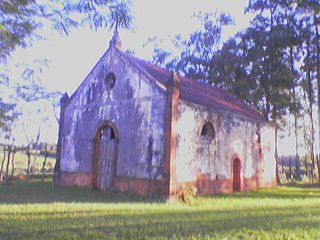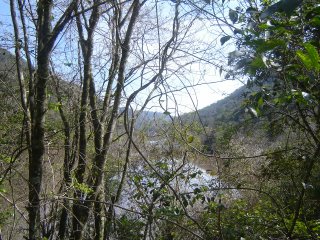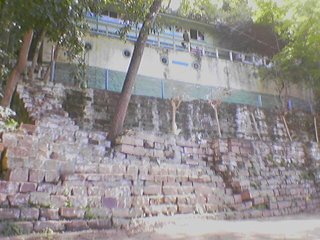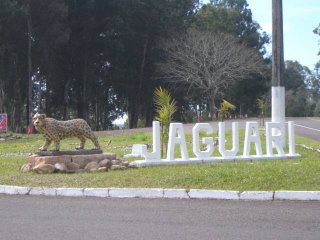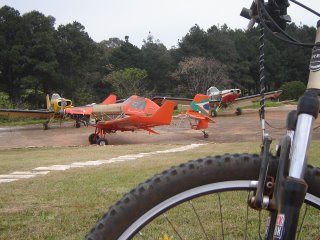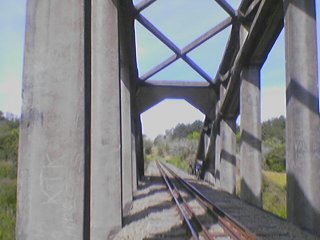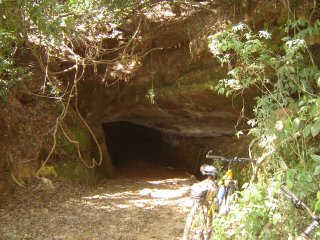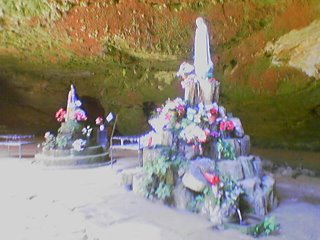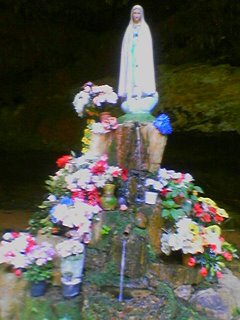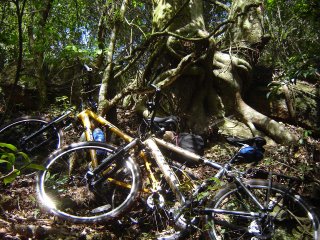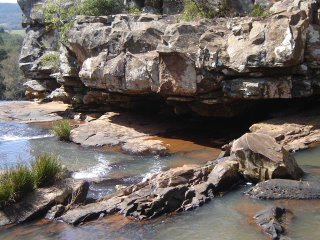(in english after the portuguese)Ernesto Alves e Arredores - Quinta Parte
Pedalamos um bom tempo naquela estrada deserta até chegarmos na fazenda.
Os peões todos paramentados de bota e bombacha estavam próximos ao galpão.
-Boa tarde!
-Buenas!
-Saberiam nos dizer onde fica o pilão d’água?
-É lâââ para aqueles lados. Peguem a estrada e sigam até um mata-burro. Ali vocês entram à direita e se vão.
Pedalamos mais um tempo em silêncio observando a imensidão dos campos. O relevo e a vegetação da região eram diferentes do trecho serrano entre Jaguari e Santiago, onde os descendentes de italianos e poloneses criam porcos e galinhas, plantam frutas e hortaliças nos seus minifúndios. Estávamos pedalando agora nos pampas, uma paisagem semelhante aos campos de cima da serra, onde existem grandes latifúndios e cuja atividade econômica principal é a criação extensiva de gado de corte.
Enfim chegamos ao mata-burro. Vimos outra fazenda ali perto e fomos até ela para pedir informações.
A água tinha acabado, e eu comecei a pensar na alimentação. Tínhamos pedalado uns 11 quilômetros naquela estrada e já passava das duas horas da tarde.
- Boa tarde. Onde fica o pilão d’água?
- É lá para aqueles lados.
- Está muito longe?
- Não muito.
- Vocês vendem queijo ou salame?
- Não temos essas coisas.
Seguimos o pedal, a estrada e o relevo foram ficando cada vez mais irregulares. Avistamos outra fazenda ao longe. Fomos até lá espantando rebanhos de gado e ovelha que havia pelo caminho.
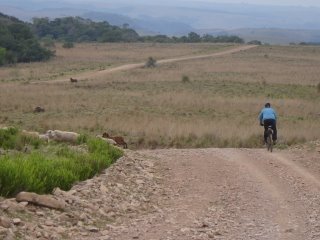
Falamos com o capataz depois de sermos recepcionados por uma cachorrada simpática.
-Boa tarde! Onde fica o pilão d’agua?
-Vocês querem fazer o quê lá?
-Vamos dar uma olhada. Não foi fácil chegar até aqui de bicicleta. Não vamos demorar. Por acaso vocês vendem queijo ou salame?
- Não vendemos isso. Mas podem ir até o pilão, só não demorem. Passem aquele mata-burro, andem uns cem metros, entrem à esquerda num campo. Vocês vão passar por um açude. Sigam pelo campo. O pilão fica a dois quilômetros e meio daqui.

Assim fizemos. Passamos o mata burro, pedalamos uns cem metros, entramos no campo, passamos o açude.
Mas a trilha no campo acabou numa cerca.

Notei que o Alberto estava visivelmente cansado. Era quase três horas da tarde e comecei a sentir fome. Comi um limão, ofereci outro para o Alberto e ele recusou. Ele trazia umas duas barras de cereais na mochila, mas estávamos guardando elas para alguma emergência, tipo hipoglicemia.
Voltamos para a estrada.
- Deve ser um pouco mais adiante.
Pedalamos mais um quilômetro na estrada e não havia mais trilhas visíveis no campo.
Resolvemos voltar e falar novamente com o capataz.
Para voltar havia uma subida, o Alberto foi ficando para trás. E para piorar a situação, começou a cair pingos d’água esporádicos.
Cheguei de volta na fazenda, o Alberto vinha bem atrás. Fiquei preocupado. Normalmente ele pedala na frente.
Então falei com o capataz.
- Não achamos o pilão d’água e a gasolina acabou.
- Gasolina?
- Vou ser franco. Não almoçamos pensando que seria fácil de chegar aqui. O nosso combustível é comida. Por acaso o senhor não teria um prato de arroz para nos vender? Pode até ser frio, sobra do almoço, nem precisa esquentar.
-Mas é claro que temos! Vamos passando para o galpão, vou trazer algo para vocês comerem!
O Alberto chegou logo depois com uma cara de fome e cansaço.
-Alberto! Consegui comida! Vamos para o galpão.
O galpão era um típico galpão de estância, desses que a gente lê nas poesias do Jaime Caetano Braun.
“Sala grande, chão batido
onde passei minha infância
querido galpão de estância
que foste um dia meu lar,
hoje aqui venho rezar,
saudoso dum teu afago,
catedral xucra do pago,
de joelhos, no teu altar”(Trecho de“Galpão de Estância” de Jayme Caetano Braun)
Ali havia um senhor de idade pilchado, tomando mate sentado num banco.
-Buenas! Fiquem à vontade, o seu Paulo foi pegar a comida.
O seu Paulo era o capataz. Havia uma cozinha atrás do galpão. Ele voltou de lá trazendo duas grandes panelas fumegantes, voltou e trouxe mais outra. Largou-as sobre uma mesa de pau onde ele já tinha colocado pratos e talheres.
-Comam a vontade!
Comemos em silêncio dois pratos cheios cada um. Tinha um arroz, feijão com grandes pedaços de couro de porco, e uma carne de panela com mandioca e batata de sabor inigualável.
- Não precisava tanto! Mas o caminho para o pilão d’água é por ali mesmo?
- É aquele mesmo.
Comecei a me preparar para voltar lá. O Alberto sentou numa cadeira forrada com pelego, e eu já de capacete e luvas.
-Vamos?
-Pode ir que eu vou ficar por aqui mesmo.
No mesmo instante começou a cair uma garoa forte.
-Agora surgiu mais outro motivo para eu não ir.
-Então eu vou sozinho. Se eu não voltar em três horas, manda alguém me procurar.
-Pode ficar tranqüilo, mandarei um helicóptero.
Voltei ao local onde havíamos nos perdido.
Passei a bicicleta para o outro lado da cerca e depois comecei a pedalar numa descida no campo. Fui em direção a um mato que eu via ao longe.
Avistei uma porteira, pedalei até lá e então pude ver marcas de veículos na grama. O caminho deveria ser por ali.
Desci um trecho relativamente longo até chegar num matagal. A chuva tinha abrandado um pouco.
Entrei pedalando num mato fechado, ouvi um rumor de águas mais à frente. Fui me aproximando e achei um lajeado onde larguei a bicicleta.

Caminhei um pouco e subi nas pedras mais altas. O que vi foi um tanto assustador: uma espécie de cânion inundado pelas águas de um rio profundo.
Era um cenário diferente, coisa de se espantar, especialmente quando se está sozinho, longe de tudo, e o tempo é chuvoso.
Tirei várias fotos e não me demorei muito naquele lugar.


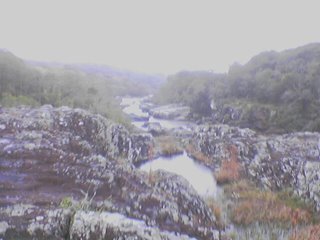
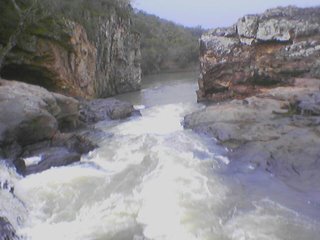
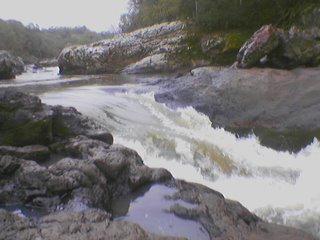
Subi com sofrimento a trilha no campo, mais empurrando a bicicleta do que pedalando. Chegando de volta na fazenda encontrei o Alberto sentado num banco, proseando com o capataz.
-Alberto, lamento, mas tu perdeste a chance de ver uma coisa impressionante!
Nos preparamos para ir embora. O Alberto colocou o capacete e fomos nos despedir do seu Paulo.
- Quanto custa o almoço e tudo mais?
- Não custa nada!
Depois de muita insistência deixamos um dinheiro com o seu Paulo. Voltamos pedalando na chuva que ficava cada vez mais forte, o Alberto ficou para trás. Esperei-o nas proximidades do aeroporto, debaixo de uma árvore.
O Alberto estava sem freio traseiro, havia perdido uma balaca no pedal do morro Chapadão. Eu estava com a suspensão travada. Por isso tinha sugerido que passassemos numa oficina de bicicletas antes de voltarmos para Ernesto Alves. Eu precisava ir até a cidade também para comprar uma bomba de chimarrão e xarope para tosse.
Pensei que ele pararia sob a árvore. Mas ele passou direto, dizendo que seguiria para casa o mais rápido possível, sem parar em lugar nenhum. Seu moletom de algodão estava encharcado. A bicicleta embarrada. A chuva era forte.
-Então segue que eu vou depois.
Fui para a cidade pedalando debaixo de chuva intensa. Comprei o xarope e a bomba de chimarrão. Parei num bar em frente ao hospital e tirei a jaqueta tida por impermeável. Ela estava encharcada. Tomei um café forte enquanto esperava a chuva passar.
Assim que a chuva abrandou peguei a bicicleta e parti pedalando o mais rápido possível para Ernesto Alves. Era quase cinco horas da tarde e eu tinha de pedalar trinta quilômetros.
Voltou a chover forte. O asfalto parecia um riacho. Os caminhões que passavam quase me derrubavam da bicicleta. Eles me jogavam água com força; chegou a entupir meu ouvido esquerdo.
Mesmo assim não desanimei, e pedalei forte. No meio do caminho parei na “casa do maristão” para comprar uma garrafa daquela bebida parecida com quentão.
Cheguei na casa do maristão, abaixo d’agua. Havia um pessoal carneando um porco dentro dum galpão.
Devem ter achado no mínimo estranho ao me verem chegar ali daquele jeito: encharcado, roupas e luvas pretas, capacete azul, óculos de proteção, pedalando uma bicicleta amarela, feliz da vida, querendo comprar maristão.
-Sirva-me uma prova antes, por favor.
A prova foi mais de meio copo.
Cheguei em Ernesto Alves quase de noite.
O Alberto disse que já estava ficando preocupado com minha demora.
Contou que furou um pneu no caminho e que depois pedalou vinte e três quilômetros torcendo para que não furasse outro. Ele só tinha uma câmara de reserva.
Lavei a bicicleta e coloquei roupas secas. Olhei o ciclocomputador; tinha pedalado 90 quilômetros naquele dia.
-Estou satisfeito. Por mim a gente não pedala mais nesse feriado.
-Boa idéia! Concordo contigo.
Tomei xarope para tosse, enchi um copo de maristão, peguei o violão:
"Bicycle bicycle bicycleI want to ride my bicyclebicycle bicycleI want to ride my bicycleI want to ride my bikeI want to ride my bicycleI want to ride it where I like"(Bicycle Race - Queen)
(continua)
Ernesto Alves and Surroundings - Fifth Part
We cycled for a good time in that desert road until arriving in a farm. The gauchos all wearing typical clothes, boots, hats, and “tirador", were next to the ranch.
- Good afternoon!
- “Buenas!”
- Could you tell us where is the water pylon?
- It is theeeere! You need take the road and follow until a “killer-donkey”. There you need enter to the right and after go ahead.
We cycled for some time in that almost plain road.
The relief and the vegetation of the region were different of the stretch between Jaguari and Santiago, where the descendants of Italians and Poles create pigs and hens, plants fruits and vegetables in its small farms. We were cycling now in Pampas, a similar landscape to the fields from above of the mountain range, where exist really big farms and whose main economic activity is the extensive creation of cut cattle.
At last we arrives in the “killer-donkey”, we saw a farm there close and we went there to ask for information. My water had finished, and I started to worry about the feeding. We had cycled 10 kilometers in that road. It had passed of the two hours of the afternoon yet.
- Good afternoon. Where it is the pylon of water?
- It in that direction.
- It is very far?
- Not very.
- Do you have cheese or sausage to sell?
- We do not have these things.
We followed the pedal. The road was being each time more irregular, the relief also. At last we saw another farm.
We went until there frightening flocks of cattle and sheep that had for that way. After being recepcioned for a lot of likeable dogs of the collie bread, we talked with the foreman of the farm.
- Good afternoon! Where it is the pylon of water?
- What do you want to make there?
- We go to give one looked at. It was not easy to arrive until here of bicycle. We do not go to delay. By chance vocês does not sell cheese or sausage?
- We do not sell them. But you can go until the pylon, but don´t delay. You need pass that killer-donkey, walk one hundred of meters, you enter to the left, in a field. So you pass for the side of a dam. Follow for the field. The pylon is o so two kilometers from here.
Thus we made. We passed the “donkey killer”, we cycled one hundred meters, we passed by the dam. But the road finished, and we finished in a fence. I noticed that the Alberto it was visibly tired. It was almost three hours of the afternoon and I already was with hunger. I ate a lemon, I offered another one for the Alberto and he refused it. He had two bars of cereals with it, but we were keeping them for some emergency, in some case of hipoglycemie.
- We came back toward the road.
- It must ahead.
We cycled more one kilometer, and saw nothing, so we decided to come back and to speak again with the foreman.
To come back there was an ascent. The Alberto was becoming backwards. And to worse the situation, started to rain sporadically.
I arrived in the farm. Alberto was distant from me. I was worried about him. Normally he cycle in front of me.
Then I spoke with the foreman.
- We did not find the water pylon, and the gas finished.
- Gas?
- I am going to be clear. We did not lunch, thinking that it would be easy to arrive here. Our fuel is food. By chance, don´t you have a plate of rice to sell us? It can be cold, don´t need to hot it.
- Surelly we have! Let´s go passing until the shed, I am going to bring something to you eat!
Alberto arrived later with a face of hunger and fatigue.
-Alberto! I obtained food! Let´s go to the shed.
It was a typical ranch farm of gauchos, like that you can read in the poetries of the Jaime Caetano Braun.
“Great room, beaten soil where I passed my infancy
wanted ranch shed, that you were one day my home,
today I come here to pray, longing you yours I fondle,
cathedral xucra of my land, of knees, in your altar”
(Stretch of “Shed of Ranch” of Jayme Caetano Braun)
There were a old man wearing typical clothes of gaucho, taking chimarrão seated in a bank
Buenas! You are wellcome, Mr Pablo went to the kitchen ttake some food to you.
Mr Pablo was the foreman. There were a kitchen behind the shed.
He came back from ther bringing two great smoky pans, came back and brought plus another one. He released them on a wood table where he had already placed plates with kinifes and forks.
- Eat what you want!
We ate in silence two full plates each one. There were rice, beans with great pig leather pieces, and a meat with cassava and potato of a good flavor.
- It was not necessary so much! But the way for the water pylon is that same way you told us?
- Yes, it is.
I started to prepare myself to come back there. Alberto seated in a chair lined with pelego, and I was with helmet and gloves yet.
- Let´s go to pylon?
- You can go, but I am going to stay here.
In the same instant became to rain again.
- Now I appeared plus another reason to me stay here.
ot to go.
- Then I am going alone. If I not to come back in three hours, orders somebody to look for me.
- Don´t worry, I will order a helicopter.
I came back to the place where we had lost the way, I faced that fence. I passed the bicycle for the other side and later I started to cycle in a descending, in the field, in direction to weeds that I could see far away. I sighted a gate, I went until there and then I could see marks of vehicles in the grass. The way would have to be there.
I went down a relatively long stretch until arriving in a mass of weeds. Rain had softened a little. I entered in closed weeds cycling after i heard a water sound ahead.
I went approaching me until face a place paved with flagstone. I released the bicycle in the rocks.
I walked a little and what i saw were frightful. A species of canion flooded by waters of a deep river. An atypical scene, thing of if frightening, especially when we are alone, far from everything, and the time is rainy.
I took off some photos and I did not delay myself very much in that place. I went up with suffering the track in the field, more pushing the bicycle than cycling.
Arriving in return in the farm I found Alberto seated in a seat lined with fur of sheep, talking with Mr Pablo.
- Alberto, it is a pity, but you lost the possibility to see a fenomenal thing!
Then we prepared ourselves to go away. Alberto placed the helmet and we asked to Mr Pablo:
- How much costs the lunch and everything?
- Cost nothing!
I released some money in the chair. We came back cycling in the rain that was each time stronger. Alberto was backwards. I waited him in the neighborhoods of the airport, underneath of a tree.
Alberto was without back brake, she had lost it in the last day, and I was with the stopped suspension damaged. Therefore I suggested for us pass a workshop of bicycles in the city before coming back toward Ernest Alves. I needed to go until the city also to buy a metal straw of chimarrão, and some medicine for cough.
I thought that he would stop under the tree, but he passed rectum saying that he would follow direct, the faster it could be possible, for the house, without stopping in any place. Its jacket of cotton was very weat. The bicycle was mooded. Rain was strong.
- Then follows ahead that I go later.
I entered in the city cicling under hard rain. I bought the medicine and the metal straw for chimarrão. I stopped in a bar in front of the hospital and took off the jacket, had for impermeable, all wet.
I took a strong coffee while i waited to pass the heavy rain.
As soon as rain softened i caught the bicycle and cycled as faster as possible to Ernest Alves. It was almost five hours of the afternoon and I had to cycle thirty kilometers in rain.
The rain came back to fall hardlly. Asphalt seemed a stream. The trucks that passed form me almost knocked down me of the bicycle, therefore they played water in torrents. The water obstructed my left ear.
I did not discourage, cycled strongly and in the way i I stopped in the “house of the maristão” to buy a bottle.
I arrived in the house of the maristão, under the rain. They were killing a pig there under inside a house.
They must have found me at least strange to seeing me to arrive in that way: under rain, black clothes and gloves, blue helmet, eyeglasses of protection, cycling a yellow bicycle, and still wanting to buy that candy and fort drink, happy with life.
-Could you give me a test of maristão?
The test was more than half cup.
I arrived in Ernest Alves almost at night. Alberto told he was being worried about my delay. He told he had pierced a tire in the way and that he cycled almos all the thirty kilometers twisting do not pierce another tire.He had only one chamber of reserve.
I washed the bicycle, and placed dry clothes.
- I am satisfied. For me we dont´t cycle more in this holiday.
- Good idea! I agree with you.
I drank the medicine for the cough, I fulled a cup with maristão drink, and took the guitar:Bicycle bicycle bicycleI want to ride my bicycle bicycle bicycleI want to ride my bicycleI want to ride my bikeI want to ride my bicycleI want to ride it where I like
(Bicycle Race - Queen)(it continues)



